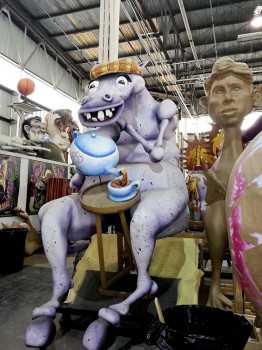
A spattering of beads flew from a passing parade of bodies. Still more launched from a passing streetcar. Traffic built up behind and around the parade, but the beads kept coming. People kept laughing, cheering, parading.
Welcome to New Orleans.
The next day I went to Kern’s Mardi Gras World—fitting after a welcome from the parade vigilantes of New Orleans. Like all museums, there was a lot to learn. The people who design the elaborate parades are called “Krewes.” Krewes mostly come from the general public, but it wouldn’t be Mardi Gras without a little royalty. The prestigious Krewe called “Rex” sets their admission fee at upwards of $100,000—so mostly you have to have blood ties to get in, like some kind of Mardi Gras Mafia.
The Big Daddy Rex Krewe is known for using grapes on their parade floats. Another famous tradition is the “King Cake”—a cake with the traditional Mardi Gras colors of yellow, purple, and green. Be careful if you get a piece of this cake—there’s a plastic baby baked into the batter, meant to represent the infant Jesus. Bite into this plastic baby, and not only could you choke, but you get to buy next year’s king cake.

For more royal fun and to end the night with a bang, Krewes traditionally host balls for themselves as a pat on the back for their hard work for Fat Tuesday. Rex gets dibs on the Super Dome, while the lesser peasant Krewes host their balls in various hotels around the area.
Mardi Gras is the bachelor party of New Orleans with extravagant parades, both planned and flash-mob-style, blast their way through the streets with colorful costumes, excited music, and dancing. It’s the one last crazy night out before slapping on the ball and chain of Lent. In the tradition of Christianity, “Fat Tuesday”—or Mardi Gras in fancy French—is the last day before Lent, the fast that comes before Easter.

Protocol for Lent includes fasting, and sacrificing or giving up certain pleasures for the next couple of months. Once the clock strikes midnight on Mardi Gras night, the observance of Lent begins, and for the next forty days observers commit to living humbly.
Why not start off the whole thing with one more night of fierce and ugly feasting and parties before having to commit to the ball-and-chain? If I learned anything in that museum, it’s that no one does it better than New Orleans.

I remember walking out of the museum and it hit me again that I was not in Washington anymore. With its own nature, its own culture and crazy bead-throwing bachelor party Mardi Gras ways. It reminded me of Portland, but weirder. Coming to New Orleans was my first trip out of the Northwest in ten years. And it just showed me that the world’s pretty weird.
Weird, but awesome.
Writing and Photos by Jeremy Hess
Edited by Kristen Buehner